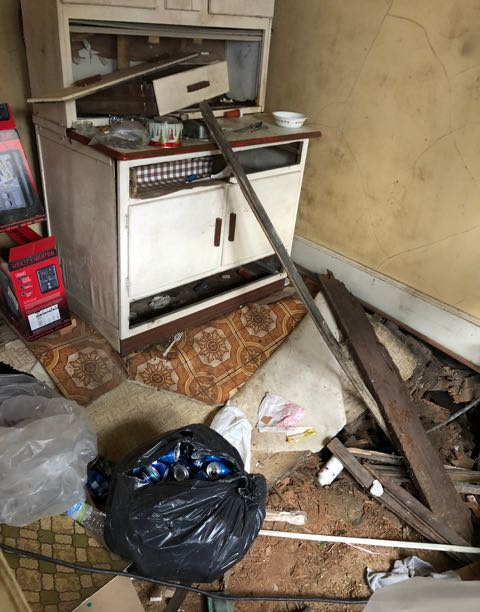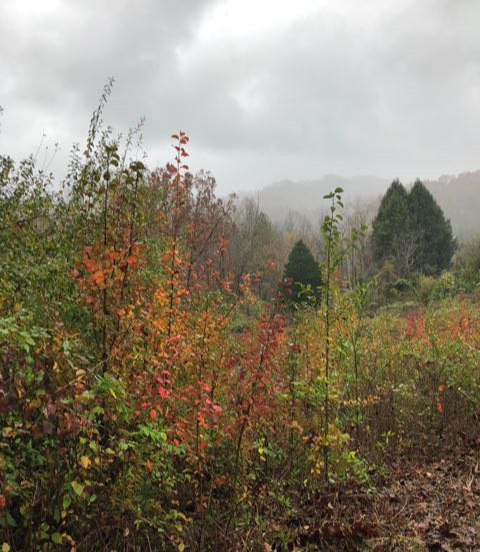It’s cold, pouring rain. The ground is a muddy, sloppy mess, and we walk carefully over the boards the grips have laid down. We’re at Reese and Ruthie’s house in Wallins, Kentucky, just up the road from Harlan.
When the locations team originally discovered the house a few weeks before the shoot started, they weren’t sure they could use it: it was an absolute wreck. Nobody had lived in it for years. But, the potential was there: under all the years of dirt and grime and garbage stood a gorgeous home with high ceilings and beautiful bones. It had once belonged to a doctor and his wife. After the husband died, the widow spent years alone, hoarding.
It required a lot of work to get the house ready for its transformation, including the removal of several Dumpsters filled with garbage. During the shoot, I stay in the kitchen, along with other crew members gathered around a monitor. We’re relegated to one small area—part of the kitchen is barricaded off because floor is literally caving in. Empty beer cans trash the filthy sink—this isn’t set dress, just a part of the house.
But when I walk down the dark, narrow hallway, around the sound and camera carts, I come to the set, where the art department has been working their magic for weeks; as Elizabeth pointed out, this is their pièce de résistance. In the dining room: a baby grand piano, old dusty 45s, a stuffed parrot in a cage. Beer cans and ashtrays mingle with the cheap figurines, along with ornate, baroque lamps; loops of Christmas garland; a silky mauve couch with floral print. Debbie De Villa spent weeks searching for the right couch, and she found it—a tacky mix of 70s glam and grandma. The set captures how I described the house in my novel: “Ruthie’s antiquated furniture (pale rose sofa, old-fashioned table lamps) mixed in with what Reese and his friends left behind (overfilled ashtrays, crumpled cigarette packs, empty bottles of Jack Daniel’s).”
The house tells us so much about Ruth and Reese—maybe in another life, another place, they would have been grand and glamorous, but here, in Dove Creek, they’re struggling to survive. The house carries their scars. Reese, high on oxy, takes care of the dying Ruthie, dreaming of Florida as the house falls apart around him.
Reese is one of the novel’s, and the film’s, most complex characters. He’s an out gay man—a tough butch queen—living in Appalachia: “By now Cole was used to Reese’s queeny walk, but the first time he saw it, he’d been shocked, his face hot with shame or maybe fear…” He takes care of Ruthie, the old woman who owns the house, and maybe the only person who ever cared about him. He’s a difficult character to pull off, but Michael Trotter’s performance is spell-binding. He captures the character beautifully: with humor and levity, layered with sadness, longing, and darkness. Reese is a tragic figure, but also a survivor—he knows himself well, and he isn’t afraid. But, he is also tired.
I first met Michael six years ago, after he’d read The Evening Hour, and wanted to turn it into a film. It’s been a long journey and Michael has been in it for the long haul—his dedication to the project has played a big hand in getting all of us here to Harlan County.
Now, on set, he’s no longer Michael, but the salty, rough, hilarious Reese. The hair, make-up, and costume crews have helped transform him: tattoos winding all over his chest, stomach, and arms; a long, messy wig; and the shortest of denim cut-offs.
The scenes with Reese are tense, even violent, and I watch several of them over the span of a few days. A scene where Cole comes over to buy pills from Reese, and we see him maybe at his most relaxed—Reese never stops with the one-liners, making Cole laugh. The terrible but powerful scene where Everett, played by Mark Menchaca (who is absolutely fantastic—intimidating, commanding, terrifying) and his cronies beat Reese up. Earlier, I watched them practice the fight sequence over at basecamp. Under the direction of a stunt director, Philip Ettinger and Tony Demil, who plays one of Everett’s roughneck friends, threw punches without making contact, moving toward and back from each other, a graceful dance.
All of the Reese scenes are riveting, but today is my favorite, focused on Reese and Ruthie. The background actor playing Ruthie, a local Harlan woman, doesn’t have any speaking parts. Old and frail, she stays in bed, while Reese sits in a chair beside her and reads to her. It’s a simple scene that captures a rare side of Reese—tender, vulnerable. Later, after they’ve finished shooting the scene, Freda, the woman playing Ruthie, tears up when she says good-bye. She hugs Michael and tells him that she wishes he’d read to her all the time. She loves all of us, she says, and it’s just one of many unexpected and genuine moments I’ve witnessed on this shoot. There are still a few more days left, but today is my last day on set, and it feels like a perfect good-bye.
Watching my novel be turned into a film has been such an incredible experience. There is so much I didn’t have time to include on this blog – the many wonderful people I met; the film lexicon I (sort of) started to learn (yes, they really do yell “Action,” “Cut” and “Rolling”); and more about the integral parts: there are so many jobs and tasks, and people who do these jobs so well. I also have a lot more to say about how this relates to fiction writing—scene building; the importance of details and specificity; texture and composition; and the process (for example, the scenes aren’t shot in order, and one scene demands numerous takes—coverage on each main character, and close and wide angles).
There are so many people to thank (there is a reason that you see so many names and job titles listed in the film credits), but for now let me just say that I’m immensely grateful to every single person who worked on this film—for their dedication and vision and expertise—and for welcoming me on set. I also want to thank the town of Harlan, Kentucky for opening their doors. I’ll continue to update my website with any exciting news on the film—from Hollerwood to Hollywood, baby. For now, as they say, That’s a wrap!









